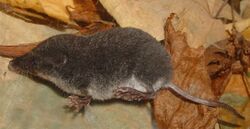Biology:Nectogalini
| Nectogalini[1] | |
|---|---|

| |
| Southern water shrew (Neomys anomalus) | |
| Scientific classification | |
| Domain: | Eukaryota |
| Kingdom: | Animalia |
| Phylum: | Chordata |
| Class: | Mammalia |
| Order: | Eulipotyphla |
| Family: | Soricidae |
| Subfamily: | Soricinae |
| Tribe: | Nectogalini Andersson, 1879 |
| Genera | |
Nectogalini is a tribe of Old World water shrews within the family Soricidae. As of late 2007, it consisted of six extant genera and 25 species, with some of the latter being further divided into subspecies. Some, but not all members of the tribe are semiaquatic.
Adaptation to semiaquatic life
Members of this tribe that are associated with a semiaquatic mode of life (Chimarrogale, Nectogale, and Neomys) have developed several lifestyle adaptations. For example, some species have stiff hairs on the sides of their toes and feet, both on their fore and hind limbs. These increase the surface area of the feet, assisting in locomotion during swimming. In addition, species such as Neomys fodiens have developed elongated tails with the hairs forming a keel-like shape that is similar in function to a rudder when the animal is in the water.[2]
Genera
- Chimarrogale (6 species)
- Chodsigoa (10 species)
- Episoriculus (4 species)
- Nectogale (monotypic)
- Neomys (3 species)
- Soriculus (monotypic)
- †Asoriculus (6 species extinct: Holocene)
- †Nesiotites (4 species extinct: Holocene)
Phylogeny of Nectogalini based on DNA and morphological characters after Bover et al. (2018).[3]
| Nectogalini |
| ||||||||||||||||||||||||||||||||||||||||||||||||||||||||||||||||||||||||||||||
References
- ↑ Anderson, J. 1879. Anatomical and zoological researches in western Yunnan. Quaritch, London, 984 pp.
- ↑ Churchfield, Sara, 1990. The Natural History of Shrews. C. Helm/A & C Black, 178 pp.
- ↑ Bover, Pere; Mitchell, Kieren J.; Llamas, Bastien; Rofes, Juan; Thomson, Vicki A.; Cuenca-Bescós, Gloria; Alcover, Josep A.; Cooper, Alan et al. (August 2018). "Molecular phylogenetics supports the origin of an endemic Balearic shrew lineage (Nesiotites) coincident with the Messinian Salinity Crisis". Molecular Phylogenetics and Evolution 125: 188–195. doi:10.1016/j.ympev.2018.03.028. PMID 29608962. http://zaguan.unizar.es/record/78769.
Wikidata ☰ Q937392 entry
 |

